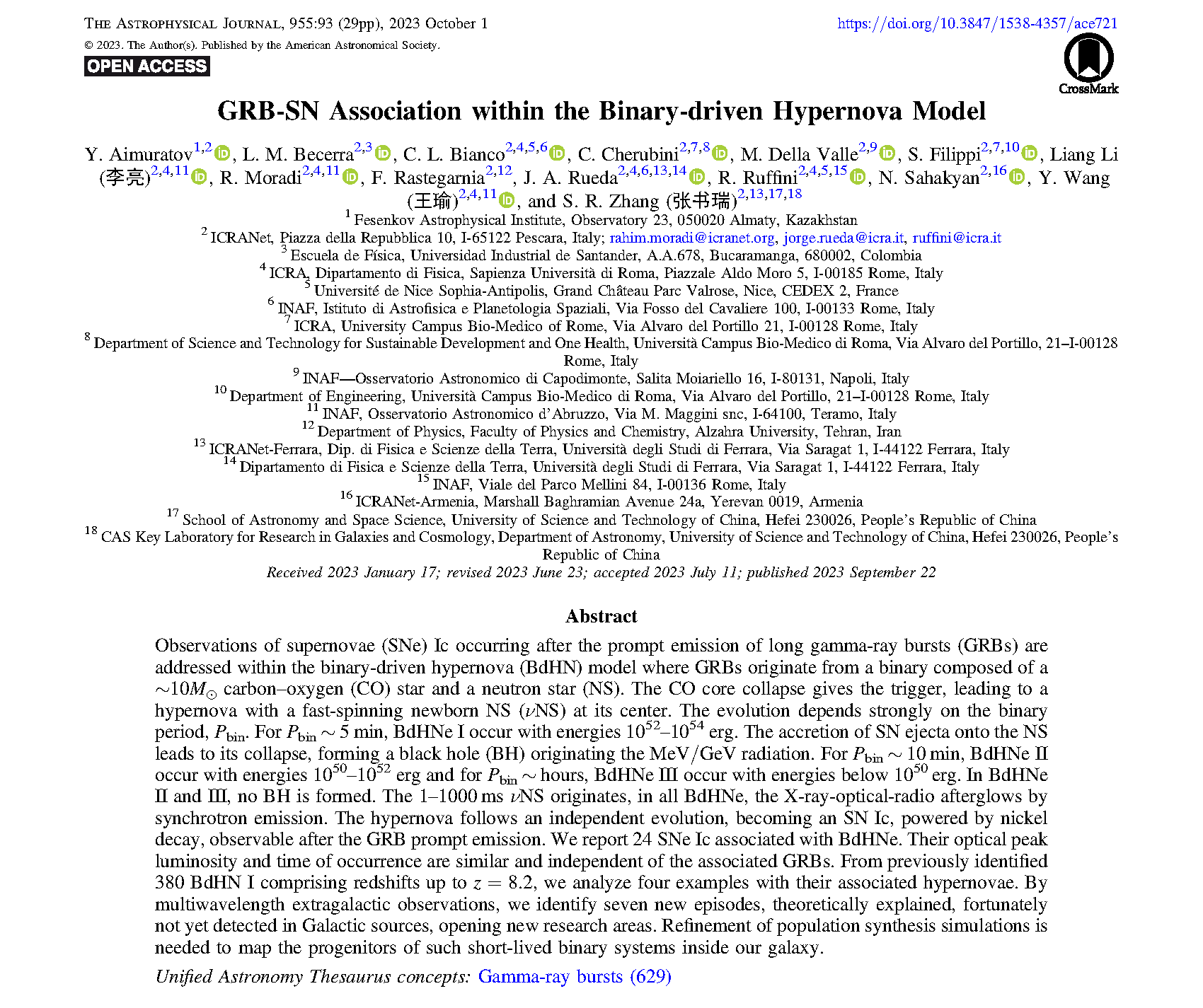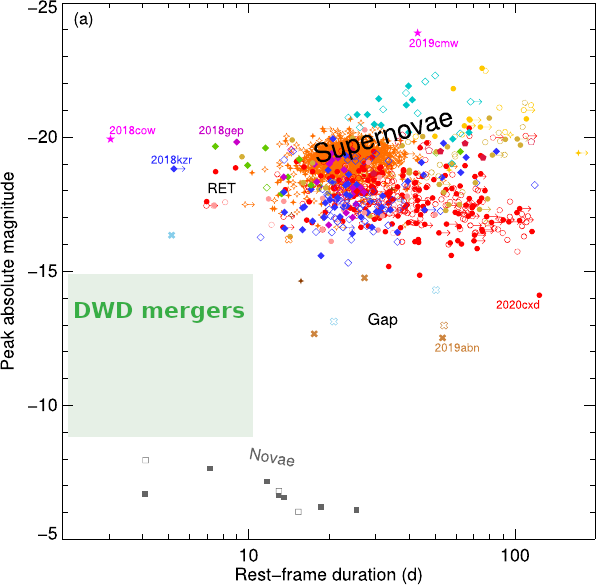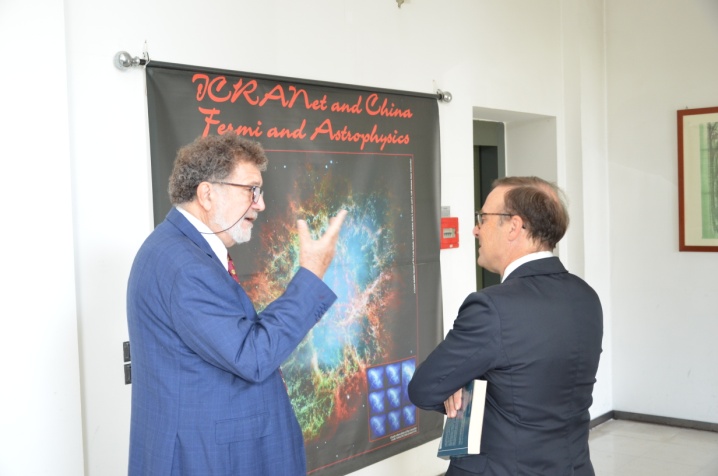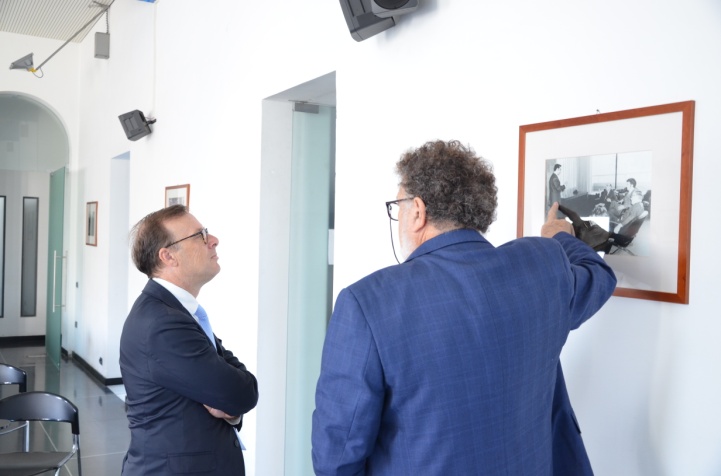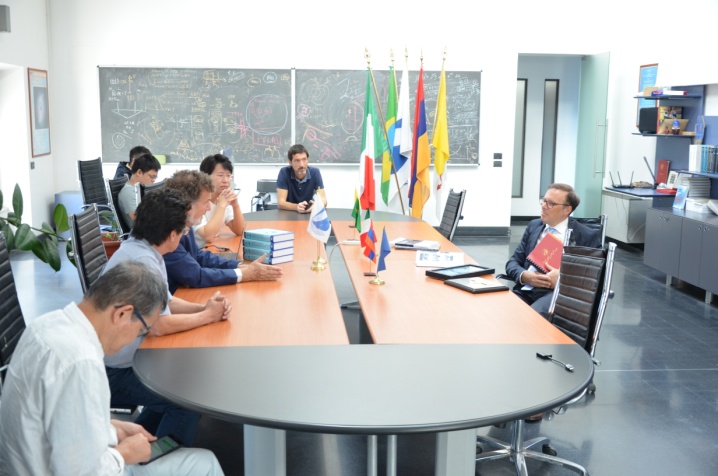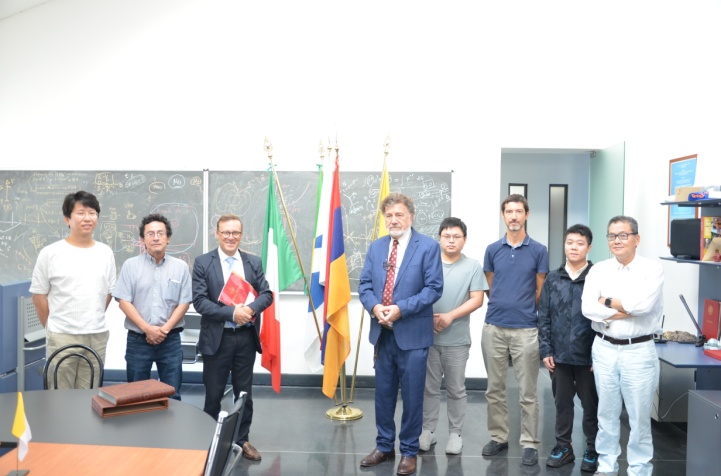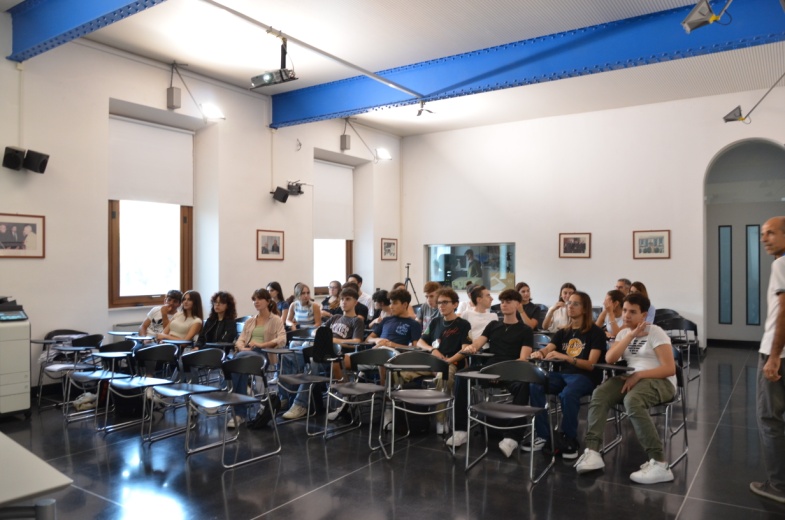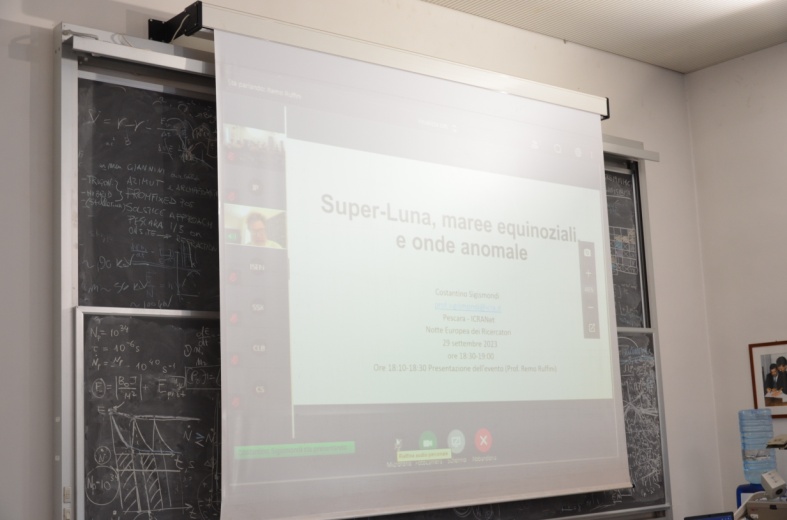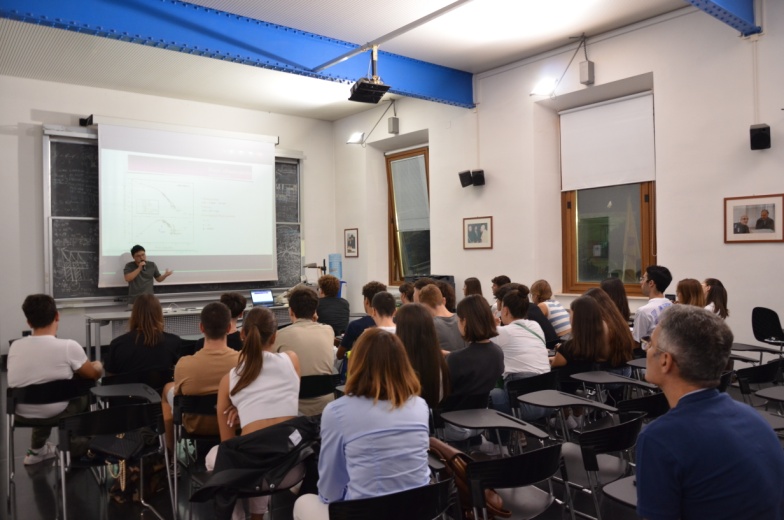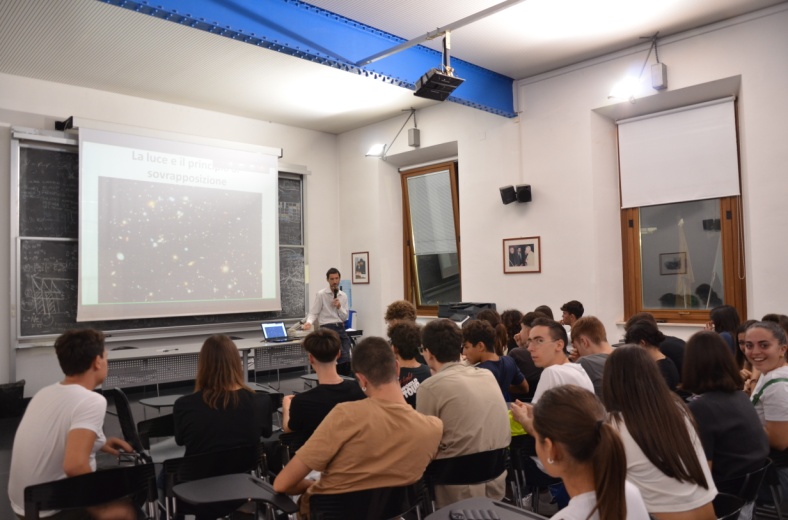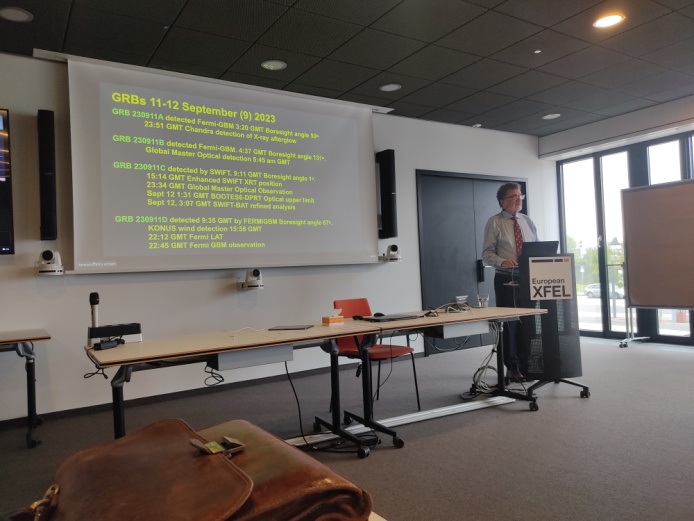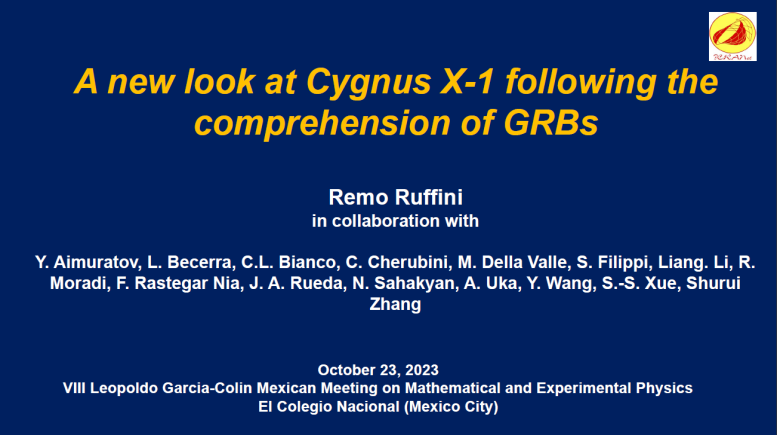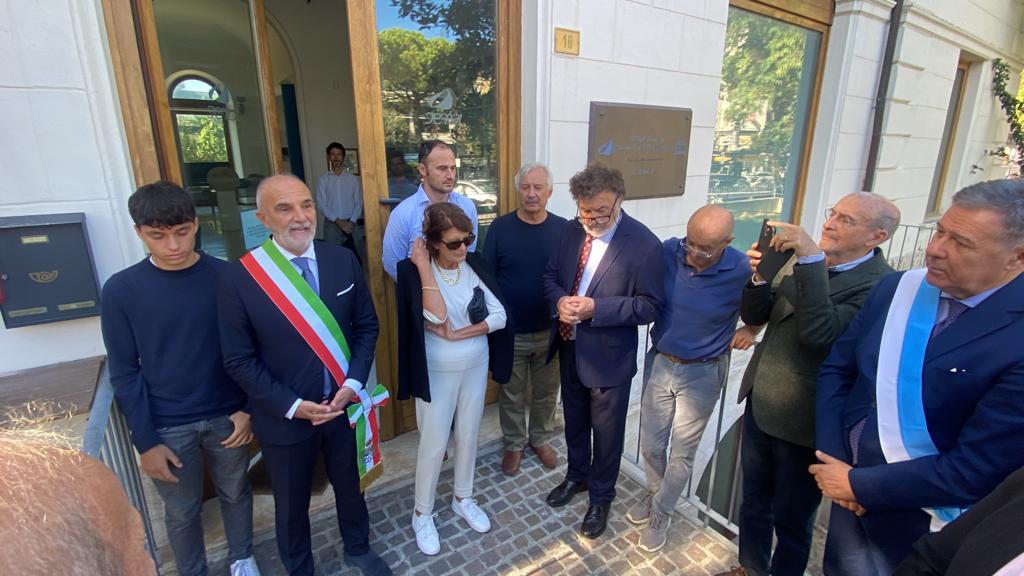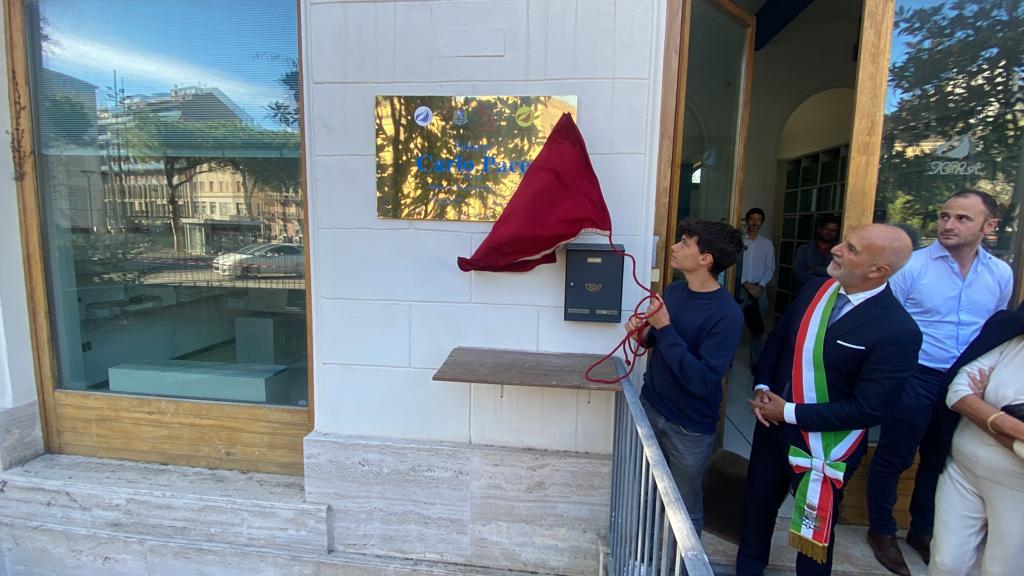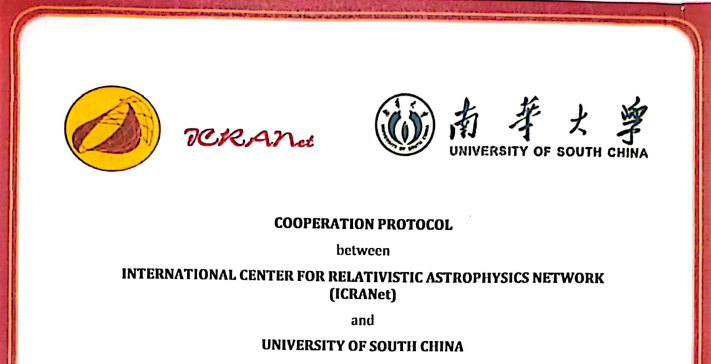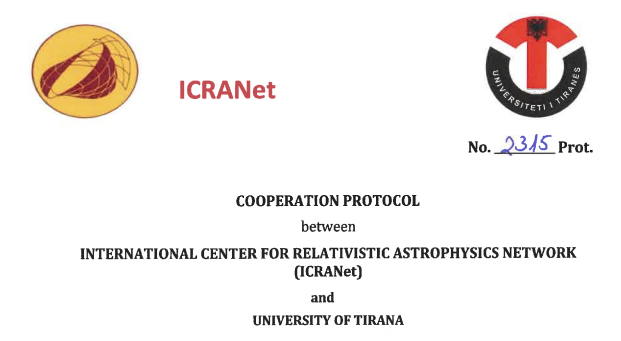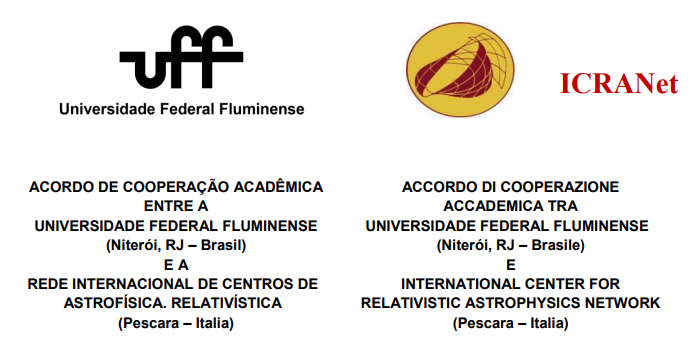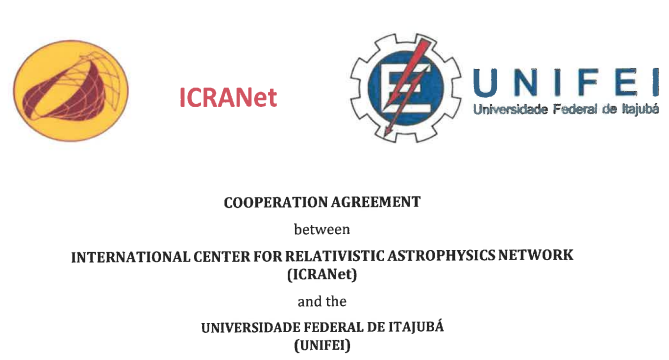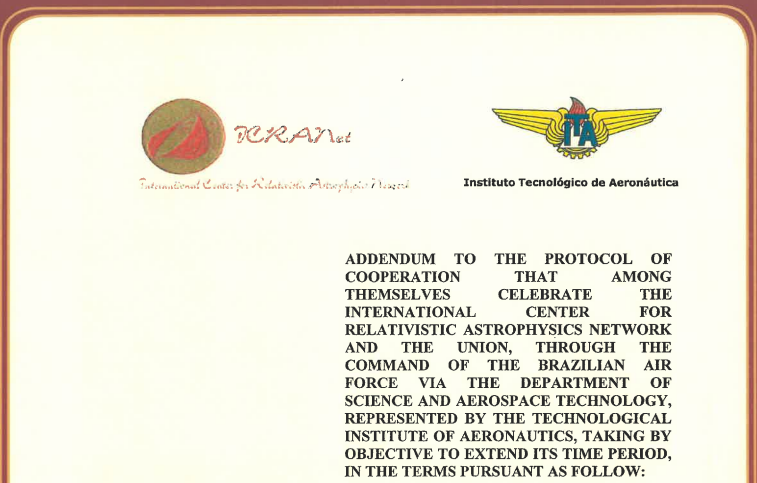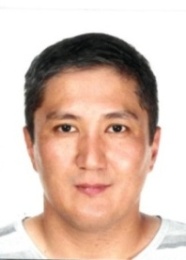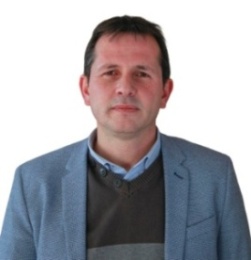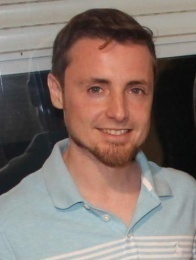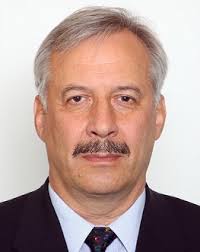

| Newsletter English September/October 2023 |

|

|



ICRANet Newsletter
2014 -
2015 -
2016
2017 - 2018 - 2019 2020 - 2021 - 2022 2023 February/March - April/May - June/July/August - September/October
ICRANet Newsletter
September/October 2023
SUMMARY
1. The paper “GRB-SN Association within the Binary-Driven Hypernova Model” by Aimuratov at al., published in ApJ, 955 (2023) 93 on October 1, 2023 2. ICRA-ICRANet press release “A New Predicted Class of Astrophysical Sources: White Dwarf Binary Mergers Poised for Discovery at The Vera Rubin Observatory”, November 2, 2023 3. ICRANet GCN 34779, September 28, 2023 4. Visit of H.E. Giancarlo Di Vincenzo, Prefect of Pescara, to the ICRANet center in Pescara, October 12, 2023 5. The European Researchers' Night, September 29, 2023 6. Prof. Ruffini European XFEL Science Seminar, XFEL Hamburg (Germany), September 12, 2023 7. ICRANet participation at the VIII Leopoldo Garcia-Colin Mexican Meeting on Mathematical and Experimental Physics, October 23-27, 2023, Mexico City (Mexico) 8. Dedication of the ICRANet Hq building to Carlo Pace, Pescara (Italy), October 28, 2023 9. New cooperation protocol between ICRANet and University of South China, September 28, 2023 10. Renewal of 5 ICRANet cooperation agreements with National Academy of Sciences of Belarus (NASB), University of Tirana, Universidade Federal Fluminense (UFF), Universidade Federal de Itajubà (UNIFEI) and Instituto Tecnológico de Aeronáutica (ITA) 11. Scientific visits to ICRANet 12. Recent publications
1.The paper “GRB-SN Association within the Binary-Driven Hypernova Model” by Aimuratov at al., published in ApJ, 955 (2023) 93 on October 1, 2023
reference article:
Y. Aimuratov, L. M. Becerra, C.L. Bianco, C. Cherubini, M. Della Valle, S. Filippi, Liang Li, R. Moradi, F. Rastegarnia, J. A. Rueda, R. Ruffini, N. Sahakyan, Y. Wang, S. R. Zhang, GRB-SN Association within the Binary-Driven Hypernova Model, ApJ, 955 (2023) 93; DOI: https://doi.org/10.3847/1538-4357/ace721
For more details, please see the previous issue of ICRANet newsletter.
2.ICRA-ICRANet press release “A New Predicted Class of Astrophysical Sources: White Dwarf Binary Mergers Poised for Discovery at The Vera Rubin Observatory”, November 2, 2023
Astrophysicists are about to take an important step forward: recent research that will be published in The Astrophysical Journal anticipates that the Vera Rubin Observatory (VRO), scheduled to release the first public datain 2025, will be able to observe a new type of astrophysical source: the merger of binary systems of white dwarfs. The research was conducted by an Italian team from the International Center for Relativistic Astrophysics Network(ICRANet) and the University of Ferrara, associates of the National Institute of Astrophysics (INAF), together withBrazilian colleagues from the Instituto Nacional de Pesquisas Espaciais (INPE), the Universidade Federal do Espìrito Santo (UFES), and the Universidade Tecnologica Federal do Paranà (UTFPR).
In some cases, it is believed that mergers of binary white dwarfs occur in a completely destructive way, producing a supernova explosion called Ia. These supernovae are regularly observed from distant galaxies. However, many of these mergers can follow a different fate: they form a massive white dwarf with an associated transient source less luminous than a supernova and with a more rapid evolution. Although they are estimated to be very abundant, these less catastrophic mergers have escaped any observation by current telescopes, as they are not sufficiently sensitive. The research predicts that the emission produced by mergers of binary systems of white dwarfs, in wavelengths from infrared to ultraviolet, will be observed by VRO with an astonishing frequency, up to a thousand per year!
The light source emitted by the material expelled at high speed (about 1000 km/s) with temperatures of 100thousand degrees for a few hours, is 10 to 100 million times brighter than the Sun. However, the rapid expansion causes the material to cool quickly, making their identification elusive. The most exciting result of the research is that, by putting together the expected population of these mergers and their emission characteristics, the researchers estimated that VRO, equipped with cutting-edge instrumentation and a wide field of view, is ready to discover these mergers in great abundance. Observing these stellar mergers will allow unprecedented insights into their birth and evolution if the predictions are confirmed. The authors say such observations will profoundly impact our knowledge of astrophysical phenomena linking massive white dwarfs to the formation of neutron stars. They will also provide crucial information on the possible generation of Type Ia supernovae from binary white dwarf mergers.
To the various types of transient sources that VRO is preparing to discover in abundance, we add the merger of binary systems of white dwarfs, whose observations will offer a revolutionary contribution to the knowledge of the life and evolution of these types of stars, including the genesis of ultraintense magnetic fields.
contact:
Prof. Jorge A. Rueda ICRANet Faculty E-mail: jorge.rueda@icra.it
Reference article: On the optical transients from double white-dwarf mergers
Authors: M.F. Sousa, J.G. Coelho, J.C.N. de Araujo, C. Guidorzi, J.A. Rueda To be published in The Astrophysical Journal Preprint: https://arxiv.org/abs/2310.06655
For the press release on ICRANet website:http://www.icranet.org/index.php?option=com_content&task=view&id=1032&Itemid=920
In Italy:
In Brazil:
Subject: transient AT2023sva: A Binary Driven Hypernova with a possible associated supernova
Date:2023-09-28T16:05:44Z From: Remo Ruffini at ICRA Via:Web form
R. Ruffini, Y. Aimuratov, L. Becerra, C.L. Bianco, C. Cherubini, S. Filippi, Liang Li, R. Moradi, F. Rastegar Nia, J.A. Rueda, N. Sahakyan, Y. Wang, S.S. Xue, S.R. Zhang, on behalf of the ICRANet team, report:
Following the BdHN classification [Aimuratov, et al., ApJ 955 (2023) 93] and the determination of the redshift z=2.2 of transient AT2023sva(de Ugarte Postigo, et al., GCN34740), from the energetics evaluated by Liang Li (2023) from Fermi GBM data in (2.15+/-0.13)x10^{52} erg (see attached figure), we conclude that the source is a BdHN II (GRB230916A).
We Propose to look with the James Webb Space Telescope the appearance of the associated supernova (SN) on October 31 (+/-1 day), in order to extend the GRB-SN connection in the range 1
4.Visit of H.E. Giancarlo Di Vincenzo, Prefect of Pescara, to the ICRANet center in Pescara, October 12, 2023
On October 12, 2023, the Prefect of Pescara, H.E. Giancarlo Di Vincenzo, visited the ICRANet center in Pescara. Prof. Remo Ruffini, Director of ICRANet, showed and presented to her the center as well as its library and the precious books, pictures and documents collected there. Prof. Ruffini illustrated as well ICRANet current activities, the main research topics and the obtained results. Also, the current projects implemented with the ICRANet center in Pescara have been presented and discussed. The important role by ICRANet in daily fostering scientific exchanges worldwide and establishing agreements with the major Universities and research Institutes worldwide was also highlighted and discussed.
Dr Di Vincenzo also met ICRANet staff, Faculty and scientists, who told him about their important work and experience here in Pescara.
As every year, ICRANet organized an event on the occasion of the European Researchers' Night, in order to create a nice occasion for discussion among citizens and researchers. This event attracted a lot of people, as every year, and offered visitors a unique opportunity to take part in science activities aiming to showcase both the fascination of research as a career and its significant societal impact.The event was held at ICRANet center in Pescara, in Nice and online, on Friday September 29, 2023, from 4 PM to 10 PM.
After the welcoming addresses by Prof. Ruffini, Director of ICRANet, the meeting started in the ICRANet Seat at Villa Ratti in Nice (France) - and broadcasted worldwide, where Prof. Ruffini presented his talk “Black Holes in the Universe”, followed by the one by Prof. Joseph Kouneiher (President of Projet Archimedes E.C.A.) titled “Les Rencontres de Villa Ratti”.
Soon after, the meeting was held in ICRANet center in Pescara (and broadcasted worldwide) and has been attended by the students from 2 classes of Galileo Galilei High School in Pescara, under the supervision of their tutor, Prof. Tiziana Pompa.Prof. Costantino Sigismondi (ICRANet collaborator and ITIS Galileo Ferraris, Rome) presented a talk titled “Super-Moon, equinoctial tides and rogue waves”, followed by Dr Liang Li (ICRANet Faculty) presenting his talk “The energy source of GRB 230916” and by Prof. Gregory Vereshchagin (ICRANet Faculty) presenting his talk “Electron-positron creation and Pauli blocking”.
Moreover, from 6 PM to 9 PM, ICRANet Hq center in Pescara was opened to the citizens for guided visits, where ICRANet Faculty members replied to visitors’ questions.
At 9 PM, the meeting went on with the broadcast of the conference by Prof. Jorge A. Rueda Hernandez (ICRANet Faculty and University of Ferrara) titled “Invisible Universe” in the framework of the project “Universo a km0”. This conference was held in Marano di Valpolicella (Italy) and has been followed by the observation of Saturn with the telescopes.
The concluding remarks have been presented by Prof. Ruffini, who thanked all the participants for joining this event.
The program of this event can be found here:http://www.icranet.org/documents/program_ruropean_researchers_night_2023.pdf
On September 12, 2023, Prof. Ruffini, Director of ICRANet, accompanied by Prof. Arban Uka (Epoka University – Albania), has been invited to give a seminar at the XFEL center in Hamburg (Germany). This seminar has been inserted in the series of the “European XFEL Science Seminars”, regularly held in Hamburg. Prof. Ruffini presented a talk titled“GRB220101A the most powerful GRB with seven BdHN Episodes observed”; here below the abstract:
A long GRB that occurred at 2022-01-01 05:11:13 (UT), was triggered by multiple satellites, including Swift (Tohuvavohu et al. 2022), Fermi (Arimoto et al. 2022), AGILE (Ursi et al. 2022), and Konus-Wind (Tsvetkova et al. 2022). The optical observation by Xinglong -2.16 m telescope (Fu et al. 2022) revealed a broad absorption feature in the spectrum indicating the presence of Lyman alpha absorption, as well as from the absorption lines, the redshift was determined to be z= 4.61, which was confirmed by the Liverpool telescope (Perley 2022) and NOT (Fynbo et al. 2022). The burst exhibited a bright , complex multi-peaked time profile within the first ~ 150 s. An estimated isotropic equivalent energy is of Eiso~4x1054 erg, and a peak luminosity is of Lp~ 9 x 1053 erg s-1, making GRB 220101 A as one of the most luminous GRB ever observed. The fact that it occurs at z=4.6 gives a great opportunity to exploit new perspectives of observations as presented in Bianco et al. 2023. The discovery of a radio source with a mean frequency of 6.0 GHz was reported in Laskar (2022a). This finding aligns with the X-ray position noted in Osborne et al. (2022), as well as the optical positions reported by Tohuvavohu et al. 2022 and Hentunen et al. (2022), along with the mm-band position mentioned in Laskar (2022b). All seven episodes characterizing a BdHN I, as predicted in Ruffini et al. (2022 a,b), have been identified, details are presented in Ruffini et al., (submitted). our attention in this article is to identify the earliest XRT observations made possible by the use of the cosmological redshift of z=4.61 and to obtain an unprecedented accurate description of the rising part and the power-law decay part of the x-ray emission evidencing the transition from a Jacobi ellipsoid into a Mac Laurin spheroid in the description of a new NS originating the afterglow.
On that occasion, he visited XFEL and DESY centers and laboratories, and also had the possibility to meet Prof. Sakura Pascarelli (scientific Director at XFEL) and Prof. Beate Heinemann (Director in charge of Particle Physics at DESY).
For the announcement of the seminar on EuXFEL website: https://indico.desy.de/event/39848/
7.ICRANet participation at the VIII Leopoldo Garcia-Colin Mexican Meeting on Mathematical and Experimental Physics, October 23-27, 2023, Mexico City (Mexico)
On October 23, 2023, Prof. Ruffini, Director of ICRANet, has been invited to present a plenary lecture on the occasion of the VIII Leopoldo Garcia-Colin Mexican Meeting on Mathematical and Experimental Physics, held in Mexico City (Mexico) from October 23 to 27, 2023.
On Monday, October 23, Prof. Ruffini presented a talk titled“A new look at Cygnus X-1 following the comprehension of GRBs-2”; here below the abstract:
The understanding of Gamma-Ray Bursts (GRBs) has used, as successful models, progenitors binary systems of massive stars of mass up to 18 solar masses. Such progenitors evolve themselves in a supernova (SN) event: the most massive of the binary undergoes an SN, forming a neutron star (NS), which remains bound to the companion less massive binary star companion. The NS induces a co-rotation on the CO core of the companion star, which undergoes a gravitational collapse, leading to an SN creating a new NS (vNS). The SN ejecta accreting onto the companion NS binary leads to the forming of a Black Hole (BH). The newly formed BH and the vNS are the basic components of the most powerful GRBs: 10 examples of CO-core collapse triggering the GRB process will be presented. The BH originates by electrodynamics process to the observed GeV emission, while the fat spinning vNS leads to the observed X-ray, optical, and radio emission of the GRB afterglow. Some preliminary results for the evolution of binary systems composed of masses higher than 18 solar masses connected to Cygnus X-1, here revisited 50 years after I identified it as a BH for the first time at the Sixth Texas Symposium on Relativistic Astrophysics in New York on December 18-22, 1972.
For the recording of Prof. Ruffini plenary lecture on ICRANet YouTube channel: https://www.youtube.com/watch?v=b00i6iKr5WM
The ICRANet Hq building, located in Piazza della Repubblica 10 in Pescara (Italy), has been dedicated to Dr Carlo Pace, former Mayor of Pescara from 1994 to 2003, accidentally dead in 2017. In order to celebrate this event, an official ceremony has been organized by the Municipality of Pescara on Saturday October 28, 2023.
Eminent local and national authorities took part in this ceremony, namely the Mayor of Pescara Carlo Masci, the President of the Regional Council Lorenzo Sospiri, the President of the Municipal Council Marcello Antonelli, the italian deputy Nazario Pagano, many Councilors and City Councilmen and the Vice Rector of the University of Chieti-Pescara Gabriele D’Annunzio Tonio Di Battista. The ceremony was attended also by the family of Carlo Pace, by civil and military authorities, by academic and cultural representatives as well as by a delegation of students from the Technical Institute Tito Acerbo of Pescara.
In the first years of 2000, Carlo Pace had the idea to transform the former train station of Pescara in a brilliant research center, that is ICRANet, since he wanted to project Pescara, the city he loved, into the knowledge of the word and of the stars, which looks at the future. As well expressed by the Mayor Masci, Carlo Pace had a great vision, great competencies and honesty. The dedication of the building to him has been strongly supported by the Municipality of Pescara, in order to commemorate a leading personality of the city administrative life, who carried out his work with self-sacrifice, carrying out brilliant cultural and human work and becoming an irreplaceable point of reference for administrators.
Prof. Ruffini, Director of ICRANet, expressed his hope that local institutions and the University would collaborate with ICRANet, in the name of Carlo Pace who believed so much in this reality. He hoped that these spaces will increasingly become places of science and research for a growing number of PhD students, as those educated by ICRANet.
For the press releases (in Italian):
For the video (in Italian):
On September 9, 2023 ICRANet has signed a new Cooperation protocol with the University of South China (USC) in China. The Cooperation Protocol has been signed by Prof. Dr. Zhang Zhuohua (President of USC), Prof. Dr. Wenbin Lin (Dean School of mathematics and physics USC), Prof. Remo Ruffini (Director of ICRANet) and Prof. Shesheng Xue (ICRANet Faculty Professor).
The agreement will be valid for 5 years and the main joint activities to be developed under their framework include: the institutional exchange of graduate, post-graduate students, researchers and faculty members, the development of teaching and/or research activities related to the areas of expertise and interest of both the organizations, the organization of symposia, seminars, conferences and short courses, the promotion and support of technical-scientific and cultural events and activities open to the public; the development of opportunities to form university teachers and researchers, the organization of training and recycling courses and activities as well as the developing of inter-institutional research areas associated to local graduate programs; the promotion of joint publications; the implementation of socially oriented activities through the academic extension; the exchange of information concerning teaching and research activities in both institutions as well as the applications to the international grant programs to promote joint research projects or implement mobility exchange programs.
For the text of the agreement: http://www.icranet.org/index.php?option=com_content&task=view&id=1500
10.Renewal of 5 ICRANet cooperation agreements with National Academy of Sciences of Belarus (NASB), University of Tirana, Universidade Federal Fluminense (UFF), Universidade Federal de Itajubà (UNIFEI) and Instituto Tecnológico de Aeronáutica (ITA)
Renewal of the cooperation agreement between ICRANet and the National Academy of Sciences of Belarus (NASB)
On September 7, 2023, the Cooperation Agreement between ICRANet and the National Academy of Sciences of Belarus (NASB) has been renewed. The renewal was signed by Academician Vladimir G. Gusakov (Chairman of the Presidium of NASB), Prof. Alexander Shumilin (Chairman of the State Committee on Science and Technology of the Republic of Belarus), Prof. Remo Ruffini (Director of ICRANet) and Prof. Gregory Vereshchagin (ICRANet Faculty Professor).This agreement will be valid for additional5 years and the main joint activities to be developed under its framework include: the conduction of joint research on scientific issues of interest to both Parties, the organization of bilateral scientific and scientific-practical events, the exchange of experience between employees involved in research and teaching, the publication of joint scientific works in international journals as well as the exchange of publications, teaching materials and lecture courses.
For the text of the agreement: http://www.icranet.org/index.php?option=com_content&task=view&id=1050
Renewal of the cooperation protocol between ICRANet and the University of Tirana (Albania)
On September 14, 2023, the Cooperation Protocol between ICRANet and the University of Tirana (Albania) has been renewed. The renewal was signed by Prof. Dr Artan Hoxha (Rector of the University of Tirana), Prof. Mimoza hafizi (University of Tirana), Prof. Remo Ruffini (Director of ICRANet) and Prof. Jorge A. Rueda H. (ICRANet Faculty Professor).This agreement will be valid for additional5 years and the main joint activities to be developed under its framework include: the conduction of joint research on scientific issues of interest to both parties, the organization of bilateral scientific and scientific-practical events, the exchange of experience between employees involved in research and teaching, the publication of joint scientific works in international journals as well as the exchange of publications, teaching materials and lecture courses.
For the text of the agreement: http://www.icranet.org/index.php?option=com_content&task=view&id=1187
Renewal of the academic cooperation agreement between ICRANet and the Universidade Federal Fluminense (UFF)
On September 20, 2023, the academic cooperation agreement between ICRANet and the Universidade Federal Fluminense – UFF (Brazil) has been renewed. The renewal was signed by Prof. Antonio Claudio Lucas da Nobrega (Rector of UFF) and by Prof. Remo Ruffini (Director of ICRANet).This agreement will be valid for additional5 years and the main joint activities to be developed under its framework include: the conduction of joint research on scientific issues of interest to both parties, the organization of bilateral scientific and scientific-practical events, the exchange of experience between employees involved in research and teaching, the publication of joint scientific works in international journals as well as the exchange of publications, teaching materials and lecture courses.
For the text of the agreement: http://www.icranet.org/index.php?option=com_content&task=view&id=1024
Renewal of the cooperation agreement between ICRANet and the Universidade Federal de Itajubà (UNIFEI)
On October 4, 2023, the cooperation agreement between ICRANet and the Universidade Federal de Itajubà - UNIFEI (Brazil) has been renewed. The renewal was signed by Prof. Dr. Tales Cleber Pimenta (Director International relations office UNIFEI),Prof. Remo Ruffini (Director of ICRANet) and Prof. Jorge A. Rueda H. (ICRANet Faculty Professor).This agreement will be valid for additional 5 years and the main joint activities to be developed under its framework include: the conduction of joint research on scientific issues of interest to both parties, the organization of bilateral scientific and scientific-practical events, the exchange of experience between employees involved in research and teaching, the publication of joint scientific works in international journals as well as the exchange of publications, teaching materials and lecture courses.
For the text of the agreement: http://www.icranet.org/index.php?option=com_content&task=view&id=1021
Renewal of the cooperation agreement between ICRANet and the Instituto Tecnológico de Aeronáutica (ITA)
On October 5, 2023 ICRANet has received the official confirmation that the agreement between ICRANet and - ITA (Brazil)was renewed. The renewal was signed by Prof. Dr. Anderson Ribeiro Correia (Rector of ITA) and by Prof. Remo Ruffini (Director of ICRANet). This agreement will be valid for additional 3 years and the main joint activities to be developed under its framework include: the conduction of joint research on scientific issues of interest to both parties, the organization of bilateral scientific and scientific-practical events, the exchange of experience between employees involved in research and teaching, the publication of joint scientific works in international journals as well as the exchange of publications, teaching materials and lecture courses.
For the text of the agreement: http://www.icranet.org/index.php?option=com_content&task=view&id=1014
During their visit, those scientists had an opportunity to discuss their scientific research and to have fruitful exchange of ideas with other researchers from ICRANet and from different parts of the world.
Y. Aimuratov, L. M. Becerra, C.L. Bianco, C. Cherubini, M. Della Valle, S. Filippi, Liang Li, R. Moradi, F. Rastegarnia, J. A. Rueda, R. Ruffini, N. Sahakyan, Y. Wang, S. R. Zhang, GRB-SN Association within the Binary-Driven Hypernova Model, published in The Astrophysical Journal 955:93 (29pp), on October 1, 2023.
Observations of supernovae (SNe) Ic occurring after the prompt emission of long gamma-ray bursts (GRBs) are addressed within the binary-driven hypernova (BdHN) model where GRBs originate from a binary composed of a ∼10M⊙carbon–oxygen (CO) star and a neutron star (NS). The CO core collapse gives the trigger, leading to a hypernova with a fast-spinning newborn NS (νNS) at its center. The evolution depends strongly on the binary period, Pbin. For Pbin∼ 5 min, BdHNe I occur with energies 1052–1054 erg. The accretion of SN ejecta onto the NS leads to its collapse, forming a black hole (BH) originating the MeV/GeV radiation. For Pbin∼ 10 min, BdHNe II occur with energies 1050–1052 erg and for Pbin∼ hours, BdHNe III occur with energies below 1050 erg. In BdHNe II and III, no BH is formed. The 1–1000 ms νNS originates, in all BdHNe, the X-ray-optical-radio afterglows by synchrotron emission. The hypernova follows an independent evolution, becoming an SN Ic, powered by nickel decay, observable after the GRB prompt emission. We report 24 SNe Ic associated with BdHNe. Their optical peak luminosity and time of occurrence are similar and independent of the associated GRBs. From previously identified 380 BdHN I comprising redshifts up to z = 8.2, we analyze four examples with their associated hypernovae. By multiwavelength extragalactic observations, we identify seven new episodes, theoretically explained, fortunately not yet detected in Galactic sources, opening new research areas. Refinement of population synthesis simulations is needed to map the progenitors of such short-lived binary systems inside our galaxy.
Rodríguez, J. F.; Rueda, J. A.; Ruffini, R.; Zuluaga, J. I.; Blanco-Iglesias, J. M.; Lorén-Aguilar, P., Chirping compact stars: gravitational radiation and detection degeneracy with binaries, published in Journal of Cosmology and Astroparticle Physics, Volume 2023, Issue 10, on October 6, 2023.
Compressible, Riemann S-type ellipsoids can emit gravitational waves (GWs) with a chirp-like behavior (hereafter chirping ellipsoids, CELs). We show that the GW frequency-amplitude evolution of CELs (mass ∼ 1 M⊙, radius ∼ 103 km, polytropic equation of state with index n ≈ 3) is indistinguishable from that emitted by double white dwarfs and by extreme mass-ratio inspirals (EMRIs) composed of an intermediate-mass (e.g. 103M⊙) black hole and a planet-like (e.g. 10-4M⊙) companion, in the frequency interval within the detector sensitivity band in which the GW emission of these systems is quasi-monochromatic. For reasonable astrophysical assumptions, the local universe density rate of CELs, double white dwarfs, and EMRIs in the mass range here considered are very similar, posing a detection-degeneracy challenge for space-based GW detectors. We outline the astrophysical implications of this CEL-binary detection degeneracy by space-based GW-detection facilities.
Rueda, J. A.; Ruffini, R.,Extracting the energy and angular momentum of a Kerr black hole, published on the European Physical Journal C, Volume 83, Issue 10, article id.960 on October 2023.
It has been thought for decades that rotating black holes (BHs) power the energetic gamma-ray bursts (GRBs) and active galactic nuclei (AGNs), but the mechanism that extracts the BH energy has remained elusive. We here show that the solution to this problem arises when the BH is immersed in an external magnetic field and ionized low-density matter. For a magnetic field parallel to the BH spin, the induced electric field accelerates electrons outward and protons inward in a conical region, centered on the BH rotation axis, and of semi-aperture angle 0 ≈60°from the BH rotation axis. For an antiparallel magnetic field, protons and electrons exchange their roles. The particles that are accelerated outward radiate off energy and angular momentum to infinity. The BH powers the process by reducing its energy and angular momentum by capturing polar protons and equatorial electrons with net negative energy and angular momentum. The electric potential allows for negative energy states outside the BH ergosphere, so the latter does not play any role in this electrodynamical BH energy extraction process.
Sousa, M. F.; Coelho, J. G.; de Araujo, J. C. N.; Guidorzi, C.; Rueda, J. A., On the optical transients from double white-dwarf mergers, accepted for publication in The Astrophysical Journal.
Double white-dwarf (DWD) mergers are relevant astrophysical sources expected to produce massive, highly-magnetized WDs, supernovae (SNe) Ia, and neutron stars (NSs). Although they are expected to be numerous sources in the sky, their detection has evaded the most advanced transient surveys. This article characterizes the optical transient expected from DWD mergers in which the central remnant is a stable (sub-Chandrasekhar) WD. We show that the expansion and cooling of the merger's dynamical ejecta lead to an optical emission peaking at 1-10 d post-merger, with luminosities of 1040-1041 erg s−1. We present simulations of the light-curves, spectra, and the color evolution of the transient. We show that these properties, together with the estimated rate of mergers, are consistent with the absence of detection, e.g., by The Zwicky Transient Facility (ZTF). More importantly, we show that the Legacy Survey of Space and Time (LSST) of the Vera C. Rubin Observatory will likely detect a few/several hundred per year, opening a new window to the physics of WDs, NSs, and SN Ia.
Punsly B., HST-1 as a window into the energetics of the jet spine of M 87, published in Astronomy & Astrophysics, Volume 677 on September 2023.
We present a new interpretation of the optical knot, HST-1, in the jet of M 87. High-sensitivity 22 GHz Very Large Array images have located HST-1 to within 6 mas of the jet axis immediately upstream. Based on 1.7 GHz Very Long Baseline Array images of a bright flare in 2005, we see that preponderance of emission in the early stages originates from an elongated region that is tilted 12.5° from the jet axis. The superluminal motion, shape, location, and the large jet-aligned optical/UV polarization suggest an identification with the putative relativistic spine of the jet. As such, energy flux estimates for HST-1, ∼870 mas from the nucleus, published in 2006, indicate that the central engine injected, Qspine ≈ 2.5 × 1041 ergs s−1, into the base of the spine about 200 yr earlier. Furthermore, previous studies have revealed a tubular protonic jet on sub-mas scales that envelopes a low luminosity core, presumably the faint spine base. It was estimated that the central engine injected, Qtubular jet ≈ 6.1 × 1041 ergs s−1, about 1.5 yr earlier. If one component of the jet is inherently more powerful, a firm constraint on total jet power in the recent past would then exist. If the emitted jet is inherently dominated by the spine (tubular jet), then the total bilaterally symmetric jet power emitted from the central engine was < 4Qspine ≈ 1.0 × 1042 ergs s−1 (< 4Qtubular jet ≈ 2.4 × 1042 ergs s−1) ∼200 (∼1.5) yr earlier. Assuming a nearly constant central engine injected jet power for ∼200 yr indicates a total jet power of ≲2 × 1042 ergs s−1 in epochs of modern observation or ≲3.5% jet production efficiency for an accretion rate of 0.001 M⊙ yr−1. Seemingly, the focus of Event Horizon Telescope Collaboration (EHTC) numerical models should be biased toward jet powers of ≲2 × 1042 ergs s−1, as opposed to larger estimates from ejections many centuries or millennia earlier.
Benaoum, Hachemi B.; Chavanis, Pierre-Henri; Luongo, Orlando; Muccino, Marco; Quevedo, Hernando, High redshift constraints on extended logotropic models, published in Astroparticle Physics, Volume 151 on September 2023.
A single logotropic fluid, responsible for the existence of the whole dark sector, is here extensively revised at intermediate redshifts. In particular, by investigating possible generalizations that conceptually overcome previous issues of standard logotropic scenarios, we fix bound over classes of logotropic models that exhibit additional terms in the equation of state. Employing σ8 measurements combined with low redshift data sets of Supernovae and Hubble observational data, we show the statistical significance of those extensions and their departure from the standard cosmological model. Evidences against generalized versions of logotropic models are, in particular, prompted. Our outcomes definitively show that any departure from the original logotropic model, including the Anton–Schmidt dark energy, are clearly disfavored at the level of perturbations and/or background cosmology. This indicates that, in order to have a logotropic fluid, plausible generalized versions of it would point out to reduce the complexity of the fluid itself, instead of adding extra terms.
Guetta, Dafne; Langella, Aurora; Gagliardini, Silvia; Della Valle, Massimo, Low- and High-energy Neutrinos from SN 2023ixf in M101, published in The Astrophysical Journal Letters, 955:L9 (7pp) on September 20, 2023.
Supernova (SN) 2023ixf in M101 is the closest SN explosion observed in the last decade. Therefore, it is a suitable test bed to study the role of jets in powering the SN ejecta. With this aim, we explored the idea that high-energy neutrinos could be produced during the interaction between the jets and the intense radiation field produced in the SN explosion and eventually be observed by the IceCube neutrino telescope. The lack of detection of such neutrinos has significantly constrained both the fraction of stellar collapses that produce jets and/or the theoretical models for neutrino production. Finally, we investigated the possibility of detecting low-energy neutrinos from SN 2023ixf with the Super- and Hyper-Kamiokande experiments, obtaining, in both cases, subthreshold estimates.
A. Bagheri Tudeshki, G.H. Bordbar, B. Eslam Panah, Effect of massive graviton on dark energy star structure, published in Physics of the Dark Universe, Volume 42, on October 2023.
The presence of massive gravitons in the field of massive gravity is considered an important factor in investigating the structure of compact objects. Hence, we are encouraged to study the dark energy star structure in the Vegh's massive gravity. We consider that the equation of state governing the inner spacetime of the star is the extended Chaplygin gas, and then using this equation of state, we numerically solve the Tolman-Oppenheimer-Volkoff (TOV) equation in massive gravity. In the following, assuming different values of free parameters defined in massive gravity, we calculate the properties of dark energy stars such as radial pressure, transverse pressure, anisotropy parameter, and other characteristics. Then, after obtaining the maximum mass and its corresponding radius, we compute redshift and compactness. The obtained results show that for this model of dark energy star, the maximum mass and its corresponding radius depend on the massive gravity's free parameters and anisotropy parameter. These results are consistent with the observational data and cover the lower mass gap. We also demonstrate that all energy conditions are satisfied for this model, and in the presence of anisotropy, the dark energy star is potentially unstable.
H. Barzegar, B. Eslam Panah, G. H. Bordbar, and M. Bigdeli, Structure of 3D gravastars in the context of massive gravity, published in Phys. Lett. B 847 (2023) 138280.
In this paper, we investigate a new model of dimensional (3D) gravitational vacuum stars (gravastars) with an isotropic matter distribution anti-de Sitter (AdS) spacetime in the context of massive gravity. For this purpose, we explore free singularity models with a specific equation of state. Using Mazur-Mottola's approach, we predict 3D gravastars as alternatives to BTZ black holes in massive gravity. We find analytical solutions to the interior of gravastars free of singularities and event horizons. For a thin shell containing an ultra-relativistic stiff fluid, we discuss length, energy, and entropy. In conclusion, the parameter of massive gravity plays a significant role in predicting the proper length, energy contents and entropy and parameters of gravastars.
B. Eslam Panah, M. Khorasani, and J. Sedaghat, Three-dimensional accelerating AdS black holes in F(R) gravity, published in Eur. Phys. J. Plus 138 (2023) 728.
The presence of massive gravitons in the field of massive gravity is considered an important factor in investigating the structure of compact objects. Hence, we are encouraged to study the dark energy star structure in the Vegh’s massive gravity. We consider that the equation of state governing the inner spacetime of the star is the extended Chaplygin gas, and then using this equation of state, we numerically solve the Tolman–Oppenheimer–Volkoff (TOV) equation in massive gravity. In the following, assuming different values of free parameters defined in massive gravity, we calculate the properties of dark energy stars such as radial pressure, transverse pressure, anisotropy parameter, and other characteristics. Then, after obtaining the maximum mass and its corresponding radius, we compute redshift and compactness. The obtained results show that for this model of dark energy star, the maximum mass and its corresponding radius depend on the massive gravity’s free parameters and anisotropy parameter. These results are consistent with the observational data and cover the lower mass gap. We also demonstrate that all energy conditions are satisfied for this model, and in the presence of anisotropy, the dark energy star is potentially unstable.
|
||||||||||||||||||||||||||||||||||||||||||||||||
|
||
